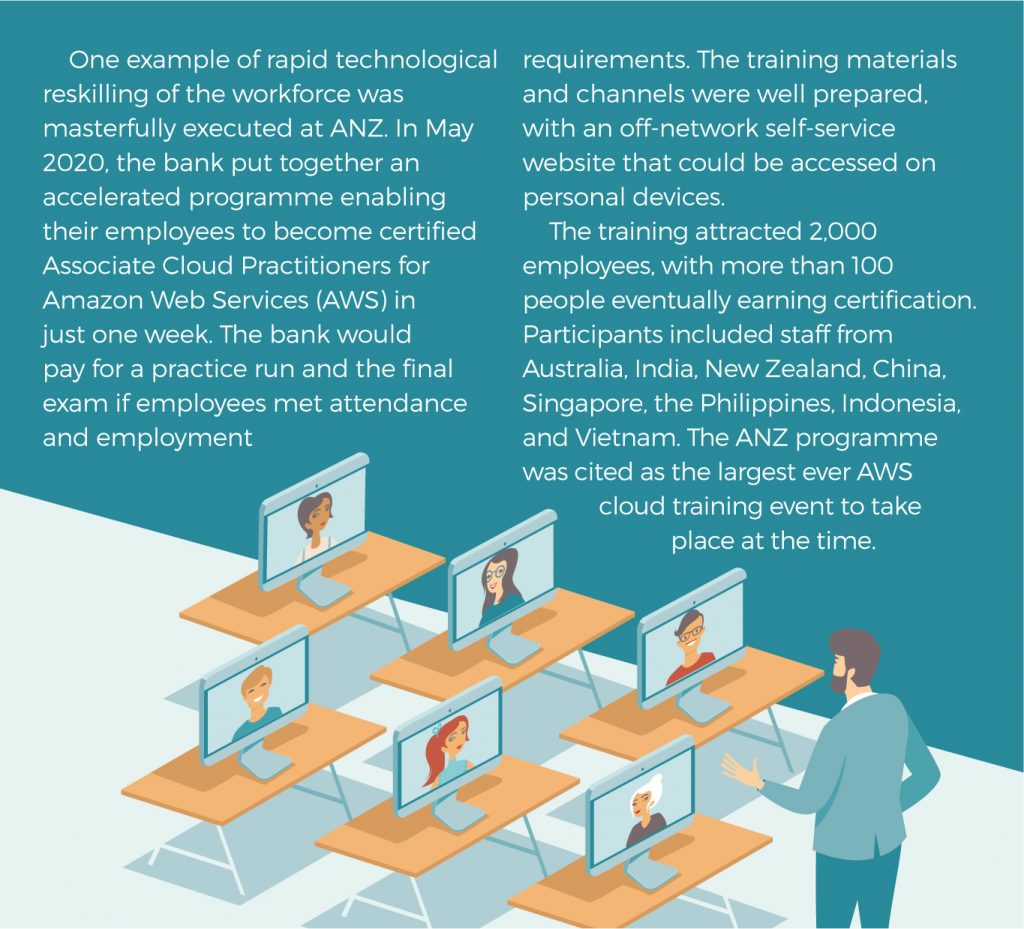Decentralisation: Doing It Right
As new work practices unfold in banks, learn to pivot quickly, but not spin out of control.

By Dr Amanda Salter
Banking has weathered the unexpected Covid-19 crisis far better than many other industries. Across all markets, from retail to investment, Asia-Pacific banks have quickly evolved ways to continue to offer critical services to customers, keeping society and economy going through the initial shock and the subsequent downturn.
One aspect of the new normal that is contributing to swifter recovery is a long overdue shift towards decentralisation in the banking operating model.
Decentralisation itself is not a new concept, and arguments (for and against) have been ongoing across the business world. In the context of a global bank, a decentralised operational structure means that decision-making takes place at a local level. Accountability, leadership, authority, and responsibility is distributed to individuals or units across multiple levels within the organisation. In other words, the person or persons closest to the customers, local regulators and the situation at hand have the control and authority to make decisions.
Findings of a 2017 joint research project by Harvard, Stanford, and MIT, titled Turbulence, Firm Decentralization and Growth in Bad Times, confirm that decentralisation helps firms to cope better with an economic downturn than their more centralised counterparts. The study found that firms which delegated more decision-making responsibility to local units performed better in the years during and immediately after the global financial crisis. This suggests that effective handling of a major increase in uncertainty involves giving control to front-line managers who have a better sense of conditions on the ground than those sitting in a remote central location.
In reality, organisations usually execute a blend of both centralised and decentralised practices. In a blended model, corporate control and global regulation can still sit as a centralised function, whilst operational decisions are made by local units. There are a number of benefits that banks are experiencing from this shift. Decentralised banks enjoy higher operational resilience and flexibility, with an increased ability to respond quickly to a changing environment and emerging constraints. Increased employee motivation also results through granting of more responsibility, thus leading to higher staff retention.
Decentralisation may seem to have an obviously positive outcome, given that Asia-Pacific banks have successfully weathered the Covid storm by applying these very practices. However, some questions still remain to be addressed in this new normal. The important action for banks now is to understand the impact and implications of decentralisation, mitigate the risks, and reinforce learnings for the future.
This article explores four key areas where opportunities and risks have been introduced by the shift towards decentralised operations, together with some ways that these risks could be mitigated.
Banks should exploit the new opportunities afforded by the global talent pool and flexible remote working practices. Forward-thinking human resource leaders can take advantage of these new capabilities to push and address thorny issues such as diversity and inclusion. We are unable to go into detail here on the myriad bottom line benefits of achieving gender-diverse board representation in banking. But it’s telling that in 2017, a global study of 71 banks in 20 countries by the SKEMA Business School found Singapore, China, Japan, and Hong Kong languishing at the bottom of the list in order of gender diversity of their banks. Asia-Pacific banks need to up their game here, and the widening talent pool can provide the chance to make inroads in hiring the right mix of people for your team.
On the flip side, the widening talent pool also means that your best employees can and will be targeted by a whole host of employers who you may not even have considered as competitors thus far, as they were outside your geography. A PwC report in July 2020, Covid-19: The Impact for Global Mobility and the Mobile Workforce, states that 43% of companies believe that the number of international remote workers will increase going forward. This is a clear risk to employee retention.

To add to this, the psychological impact of the changes and uncertainty that employees are experiencing at work and in their personal lives can lead to lower staff morale, lower productivity or motivation, or ultimately, staff resignations. There needs to be an enhanced commitment to evolving our understanding of and response to employee mental health and well-being issues. Banks need to find new ways to support, reward, and care for their employees to ensure retention stays high. Leaders need to focus on the employee experience even more than before, especially now when increasing numbers of new hires are interviewed, offered, inducted, and trained entirely remotely.
At the beginning of the crisis, the enforced digital transformation left some banks short of the right talent. This created an impetus for rapid reskilling of employees, but there is still room for improvement across the new people profiles. Banks now have the opportunity to formalise flexible pathways for reskilling and cross-train employees to move them flexibly and quickly from one role to another in response to fast-changing demand. Forward-thinking banks are also spotting the opportunity to invest in remote learning and development of their employees, especially in critical IT skills (see box story on page 32). In addition, hiring criteria may need to formally change, as employers now need individuals who are self-starters, resilient, and can collaborate and thrive in a remote working environment.
Managerial skills also need to evolve. Leaders who used to be able to ‘walk the floor’ may now feel increasingly disconnected from their teams. With less information on hand to help them manage performance, leaders may default to a narrower set of metrics for measuring success, which in turn may drive a decrease in employee motivation or performance.
Leading in the new normal needs greater emphasis on soft skills such as building trust, managing expectations, and dealing with uncertainty. Leaders need to be champions of remote collaboration, and be able to lead by example in building and working with remote teams. Leaders of successful teams will be those who demonstrate trust that their team is getting the work done despite not being on the premises. Open communication, integrity, and empathy are key, and may be difficult especially when leaders themselves are under stress. Training and support may be needed in this area, along with a whole host of other skills recently discussed in the AICB’s Banker of the Future webinar (see page 6).
Regulators are looking to hold banks and their leaders to account for the conduct and culture in their firm. A strong corporate culture is a must-have to keep a distributed workforce resilient and to support good decision-making, especially in difficult times. However, banks may need new tactics to build and maintain core corporate culture and values, and this may not be straightforward in the context of decentralised hiring and remote working. Insight, the UK Financial Conduct Authority’s (FCA) publication to help financial markets work effectively, highlights the increased risk of misconduct when employees are working unobserved, including the lack of ethical cues from colleagues and a perception of reduced personal accountability.

To combat this, banks need to create a healthy workplace culture and drive the right behaviours. The FCA describes four drivers of culture: purpose, leadership, governance, and the approach to reward and managing people. The way that banks reinforce culture across each of these four drivers may need to change and adapt to build a strong culture across a distributed workforce.
Managers and leaders play a major role in building and disseminating core culture and values. They should clearly communicate purpose and vision in a way that motivates people, unites distributed teams, and provides stability and direction. New ways should be created to empower the workforce to raise any concerns. Leaders should visibly demonstrate that they hold every individual accountable for their own behaviour, even in a remote workplace, and it is necessary to put new practices in place to remain close to the work that is happening and the team members carrying it out.
Having dealt with the immediate need to manage liquidity post-Covid, the opportunity is ripe for banks to look at transforming treasury functions strategically for the longer term. Rapid policy and regulatory changes have reinforced the credibility of a decentralised or at least ‘centrally decentralised’ treasury model. Such models empower local management, giving them control over cash operations with support from regional bases, whilst corporate control and group-wide reporting responsibilities rest centrally.
To support a decentralised treasury model, and also the decentralised teams who manage it, there is a pressing need for a real-time, virtual, predictive, global view of the cash position across all country units. Such a system must be accessible anywhere, anytime, and take into account local regulations, tax, and compliance issues.
Forward-thinking banks are already exploring new technologies to support not only their own but their clients’ treasury needs with new methods of data connectivity, from cloud-based platforms to data sharing via APIs (application programming interfaces). Treasurers need to expand their traditional toolkit to include skills in new proposition development and digital technology for a more effective global treasury.
There are, of course, corresponding risks involved when considering this level of transformation to such a key function within a bank. Strong governance, as always, is needed to ensure risks are managed and mitigated. A central governance team should still be responsible for control and reporting at a global corporate level. There must be thorough reviews of new policies with processes, training, and resources in place. Any new technology must be rigorously and aggressively tested before it can be made fully operational. As the solution needs to span multiple countries, it’s critical that local country units are consulted and involved throughout to ensure their individual needs are understood and met.
A successful solution in this space would also go far towards fulfilling the regulator’s requirements to demonstrate resolvability. However, the challenge and associated risk of having to deal with multiple legal entities, multiple decision makers and a higher degree of complexity in terms of distributed governance will still remain.
To conclude, we must address the general concept of the decentralised model, namely, that decisions are made by autonomous local units. Empowering frontliners in this way helps to achieve quicker turnarounds, maximising the bank’s ability to respond and react to change in timely fashion, but the risks here are no less significant. When decisions are spread across multiple units in different locations, if these are not controlled and communicated correctly, the wrong decisions could be made and remain undiscovered until it’s too late. Some decisions with no clear ownership could also fall through the cracks.
To mitigate this, banks should aim to capture and clearly communicate decision rights to everyone concerned. This entails clearly and formally granting autonomy and discretionary power to the correct individuals and units, at the right levels, and then ensuring everyone knows exactly who is responsible for making the decision. All decisions should be fully traceable, with remote sign-off processes in place.
Leaders also need to ensure that employees are empowered to raise concerns or challenge any decisions that are made at speed as unforeseen circumstances are likely to arise. It is crucial for to create safe spaces for employees to raise challenges without fear of punishment.
Central functions such as risk management, policies and standards, methods and audit still need to be maintained in an optimal blend of decentralised-centralised models. All central functions need to remain strong and not defer to local units, no matter how profitable or powerful the local units are.
Despite the risks, it’s clear that the disruption of finance via next-generation operational models built on the principles of shared governance and devolution of power will continue.
As banks reap the benefits of an increasingly decentralised operating model achieved within an accelerated timeframe, what remains now is to identify and mitigate the emerging risks posed by these changes, and lock in wins for the long term.
Dr Amanda Salter is Associate Director at Akasaa. She has delivered award-winning global customer experience (CX) strategies and her recent guest lecture at the University of Cambridge shared insights from architecting impactful CX. Dr Salter holds a PhD in Human Centred Web Design, BSc (Hons) Computing Science, First Class, and is a certified member of the UK’s Market Research Society and Association for Qualitative Research.